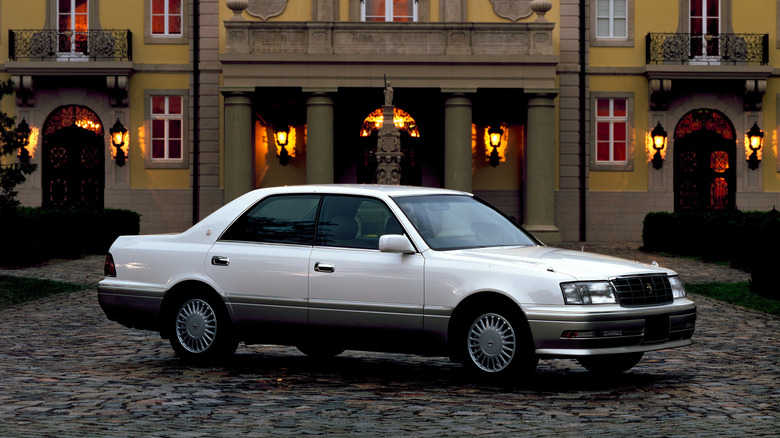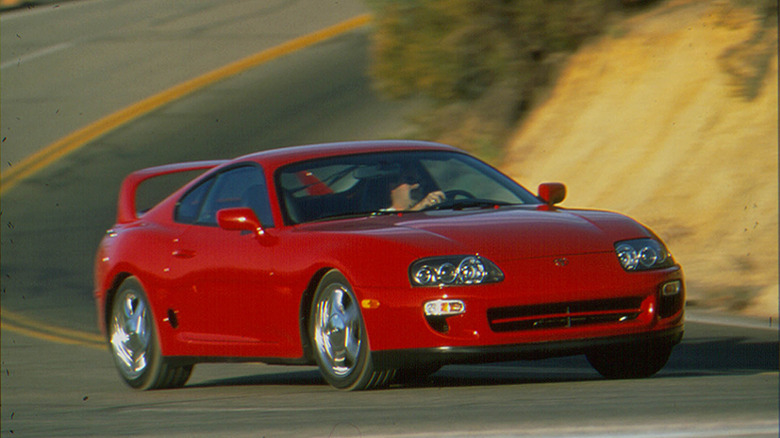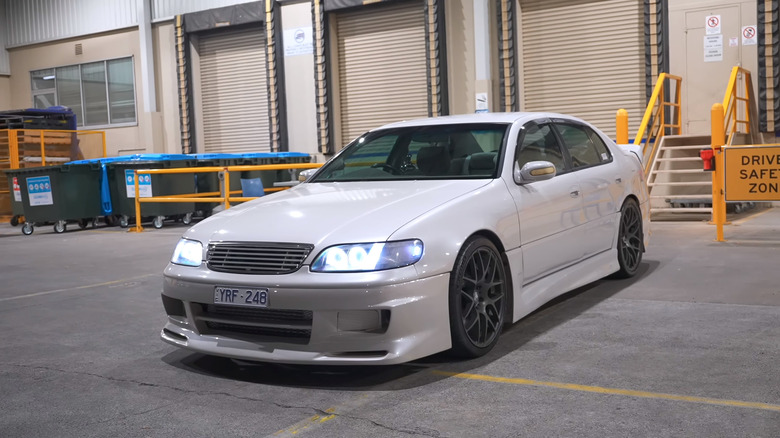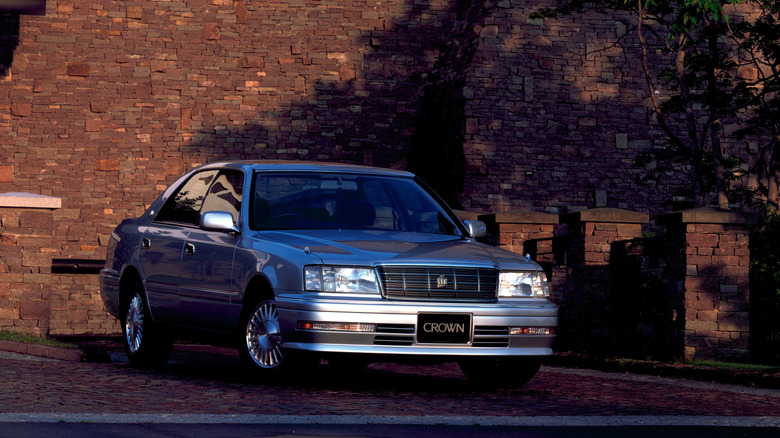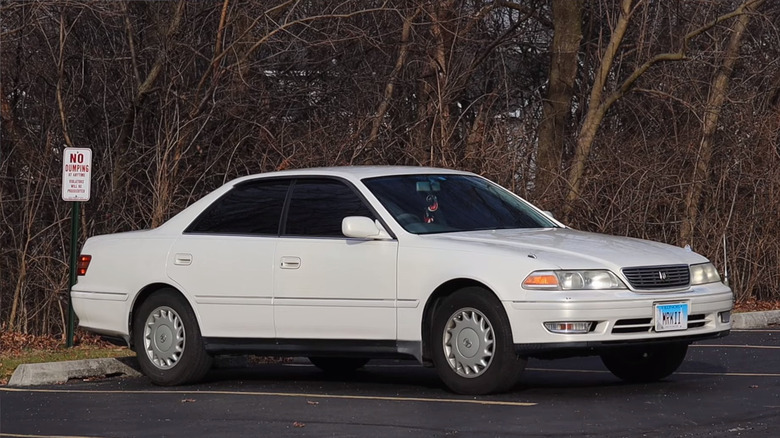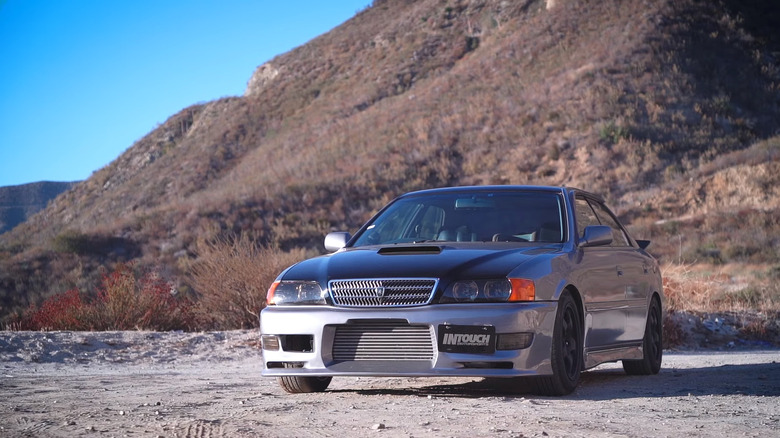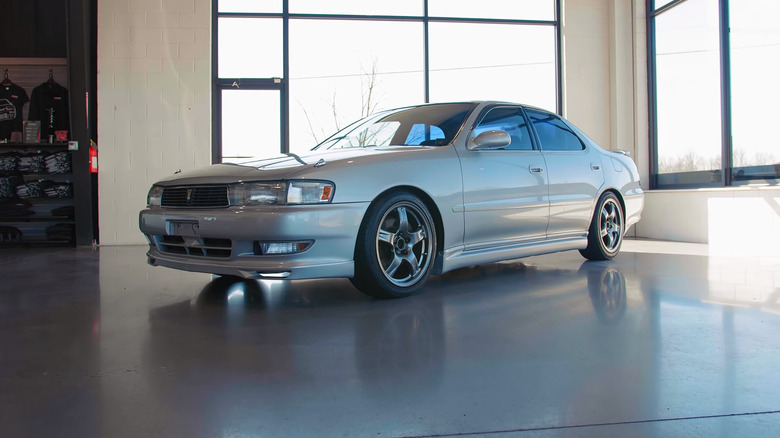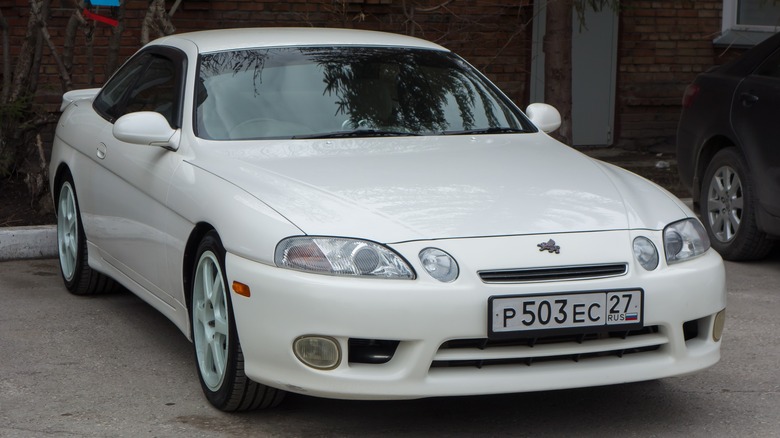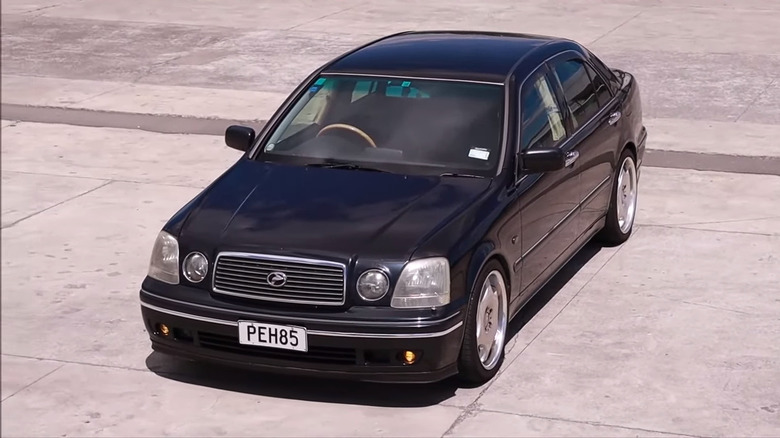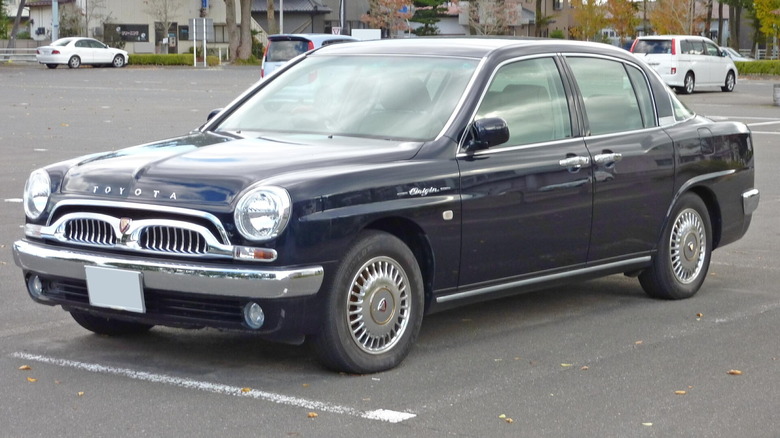Every Toyota Model Powered By The 2JZ-GE Engine
Toyota's 2JZ-GTE engine and its massive power ceiling are almost mythical at this point, with the code ringing a bell in the ears of millions of enthusiasts worldwide. While this turbocharged, 3.0-liter inline-six monster is definitely special, it is unattainable for most enthusiasts today, as prices skyrocketed due to its reputation and high demand. Fortunately, you can taste the special 2JZ sauce with the naturally aspirated GE variant, which has most of the same components minus the forced induction bits and reinforcements.
Other than that, though, the 2JZ-GE is a very sound engine designed for long mileage. Like its GTE sibling, it also features a stout cast iron block, forged crankshaft, and hot-forged connecting rods. As a result, with proper maintenance, the 2JZ-GE can easily surpass the 300,000-mile mark, making it one of the most reliable JDM engines ever made. That is especially true for the pre-VVTi versions (1991-1997), which are considered more reliable. Still, apart from fixable issues, like oil leaks and water pump failures, the 2JZ-GE VVTi engines are very durable in their own right.
Apart from its reliability, the 2JZ-GE engine provides smoother power delivery and might be more enjoyable among purists. It's also a great platform for tuning, with excellent aftermarket support.
Where can you find the 2JZ-GE engine? In this article, we'll guide you through every Toyota vehicle that featured this powertrain — from cars you are probably familiar with to some fringe models. Here is every Toyota model powered by the 2JZ-GE engine.
Toyota Supra A80 (1993-2002)
The Toyota Supra MK IV is iconic mainly for its turbocharged 2JZ-GTE marvel, but that wasn't the only engine option available at the time. The entry-level model actually had the naturally aspirated 3.0-liter 2JZ-GE under the bonnet, producing 220 horsepower at 5,800 rpm and 210 lb-ft of torque at 4,800 rpm. Sure, these numbers don't sound exciting, but the base Supra was more of a grand tourer, anyway. Instead of chasing the ultimate driving experience, Toyota went with a softer suspension on this model, which provided a smoother ride.
And that 2JZ-GE engine? Thanks to its inherently balanced inline-six nature, it is buttery-smooth up to its 6,800-rpm redline. Toyota also paired it with a five-speed manual with good shifting quality, which added to the experience. Besides, with a 0-60 mph time of 6.2 seconds and a 140-mph top speed, the non-turbo Supra MK IV was certainly no slouch, especially when compared to other sports cars from the 90s. This was not the model Toyota engineered to compete with Ferraris and Porsches; instead, it was a step-up sports car to the Celicas and MR2s of the world.
Today, many people overlook the base Supra as more of a peculiarity rather than a unique sports car. Even if correct, those people miss the point. Despite its tame nature, the 2JZ-GE-powered MK IV has Toyota's "overbuilt" quality all over it, from its engine to the interior. It's a top-quality luxurious grand tourer designed to last, so don't smirk when you see one.
Toyota Altezza Gita A300 (1998-2005)
The Toyota Altezza holds a special place among JDM enthusiasts. A sports sedan/station wagon designed to compete with BMW's Three-Series, the Altezza, also known as the Lexus IS in North America and Europe, captured attention with its attractive styling, sporty RWD chassis, and excellent selection of engines.
One of the options in the stylish "SportCross" wagon version was the 2JZ-GE, which in this iteration produced 217 horsepower and was paired to either a four-speed (AWD) or five-speed (RWD) automatic transmission. It is the same engine that powered the Lexus IS300, meaning it propelled the Altezza to 60 mph in around eight seconds and up to a 143 mph top speed. Although the 3.0-liter inline-six unit was the most powerful on offer, it wasn't the most exciting engine in the Altezza. The 2JZ-GE provided solid acceleration, but it was never designed to be the performance option.
For those who wanted more thrill, there was the Altezza RS200 model with, wait for it, a four-cylinder 3S-GE engine. This was not your typical four-cylinder, though – it was a high-revving engine equipped with Toyota's BEAMS (Breakthrough Engine with Advanced Mechanism System). As a result, it produced 207 horsepower at 7,600 rpm – not bad for a naturally aspirated 2.0-liter unit. It was also paired with a six-speed manual for maximum driving pleasure. Perhaps the biggest advantage it had over the 2JZ-GE-powered A300 variant was that it weighed a staggering 287 pounds less (2,954 pounds vs. 3,241 pounds) and had a perfectly even weight distribution, giving it much better handling balance.
Toyota Aristo (1991-2005)
Much like the Altezza is the same car as the first-gen Lexus IS, the Aristo shares most of the bits with the GS. Unlike its Lexus counterpart, though, the JDM-only Aristo came with the 2JZ-GTE turbocharged engine in both the first and second generation, producing 280 horsepower in both instances. This, along with the fact that it's an RWD executive sedan, makes the Aristo a darling among tuners worldwide. It is luxurious, too, sharing most of its interior bits with the first and second-gen GS. Think of it as the GS-F from the 1990s, and you won't be far off.
The entry-level Aristo had the naturally aspirated 2JZ-GE, similar to the GS 300. Toyota at least made it a bit more powerful for the Aristo because this was a larger and heavier vehicle compared to the lightweight Altezza, tipping the scales at 1,580 kilograms (3,483 pounds) in the first generation and 1,600 kilograms (3,527 pounds) in the second generation. With 227 horsepower and 224 lb-ft of torque on tap, the base Aristo was no slouch, especially for the 1990s.
Unfortunately, Toyota only offered this variant with a four-speed automatic, killing most of the fun. Still, the 2JZ-GE-powered Aristo was never intended to be a sports car but a smooth and refined long-distance machine that also happens to handle well in the corners. While you could meddle with the naturally aspirated inline-six, going directly for the 2JZ-GTE variant makes tuning far more straightforward.
Toyota Crown (1991-1999)
The Crown has been Toyota's flagship vehicle intended for Japan's general public for almost seven decades now. With this sedan, Toyota has always shown its engineering capabilities by incorporating the latest powertrain technologies, akin to a JDM Lexus executive sedan. This means that the Crown has always been equipped with more cylinders than other Toyota vehicles, like the 1UZ-FE 4.0-liter V8 in the eight-gen Crown facelift. It is completely different from the strange hybrid sedan we have today in the U.S.
Like most RWD Toyota sedans from the 1990s, the Crown has also been equipped with the 2JZ-GE inline-six unit in the eight-gen facelifted model and the ninth-gen model. Introduced in 1991, the first 2JZ-GE-powered Crown had 227 horsepower on tap and was paired with a four-speed automatic transmission. For the next generation, Toyota used an improved 2JZ-GE engine with VVT-i, which is meant to improve low and medium torque by optimizing the airflow inside the engine. The improved version still made 227 horsepower and 202 lb-ft of torque but made them available through a broader RPM range.
The V8 and inline-six units were perfect for the Crown, as this was meant to be a luxurious, buttery-smooth sedan. As such, Toyota made big noise-suppression efforts in each generation and even equipped the ninth-gen Crown with pneumatic suspension for a smoother ride. Meanwhile, to showcase its tech superiority over its German rivals, Toyota even offered the Electro-Multivision system, which enabled voice-guided GPS with traffic information and onboard television in 1995.
Toyota Mark II (1992-2000)
The Mark II is another variation of Toyota's RWD sedan formula. In fact, this sleek-looking sedan shared the same platform with the Crown during the 1990s (same 2,730-millimeter wheelbase) and served as a slightly sportier alternative. This means that it also shared most of the engines, with the 2JZ-GE variant being offered in the seventh- and -eighth-gen models. In the Mark II, the 3.0-liter inline-six unit made 220 horsepower and 217 lb-ft of torque, enough for a top speed of 130 mph. Much like in the Crown, the engine was paired to a sluggish four-speed automatic transmission.
Still, the Mark II is a popular car among enthusiasts, but not the version with the 2JZ-GE engine. That's because the seventh and eighth-generation models were also offered with the 1JZ-GTE 2.5-liter twin-turbo inline-six producing 280 horsepower and 279 lb-ft of torque — almost the same engine as the coveted 2JZ-GTE, albeit with a shorter stroke. Toyota also offered the Mark II with a five-speed manual or four-speed automatic transmission. Thanks largely to the 1JZ-GTE engine, the Mark II is a popular import in the United States.
Toyota Chaser (1992-2001)
Toyota has several dealership sales channels in the U.S., allowing it to sell two slightly different variants of the same vehicle. So, the fifth- and -sixth-gen Chaser is almost the same vehicle as the seventh- and -eighth-gen Mark II, though it was intended as the performance option. It also received some styling changes and different trim options. On the styling front, the Chaser had a slightly more European design, with more compact headlights and taillights. Inside, they were mostly similar, though.
Furthermore, both models were equipped with the 2JZ-GE engine, producing the same 220 horsepower, though the Chaser was also offered with AWD. Sadly, it only came equipped with a four-speed automatic. As is the case with the Mark II, the turbocharged 1JZ-GTE Chaser is the more popular option among tuners, as it's easier to extract power from. With a more expensive turbo kit and the necessary internal upgrades, however, the 2JZ Chaser is a better platform for high horsepower builds.
Toyota Cresta (1992-2001)
The Cresta is the most luxurious mid-size executive sedan of the Mark II/Chaser/Cresta trio. This is the same car as the other two, albeit offered to buyers who wanted more luxury rather than performance. All of them also shared the platform with the Crown from the 1990s, though that sedan was longer, despite having the same wheelbase. Confusing? Well, that's how Toyota operates in its domestic market. Even today, the automotive giant offers several different models based on the same platform.
Although the Cresta wasn't performance-oriented, Toyota still offered the turbocharged 1JZ-GTE engine on this model. Moreover, it shared the 2JZ-GE engine producing 220 horsepower with the Mark II and Chaser, along with the 2.5-liter 1JZ-GE with 200 horsepower, both paired to a four-speed automatic. Thus, even though the Cresta name is not as popular in tuning circles as the Chaser, it's a good project car for high-horsepower builds, particularly if you do a manual gearbox swap.
Toyota Soarer (1991-2000)
If you wanted a luxury grand tourer from Toyota in the 1990s, the third-gen Soarer was the car to go for. Sleek lines, a luxurious interior, and a V8 option differentiated the Soarer from the MK IV Supra A80. Thus, the Soarer served as Toyota's halo car during that era. If this classy coupe looks familiar, it's because Toyota offered it in North America as the Lexus SC. In some ways, though, the JDM Soarer was more advanced, as it came with an optional electronically controlled air suspension and active four-wheel-steering (the world's first), both of which improved comfort and dynamics.
Similar to its North American SC 400 counterpart, the Soarer came equipped with the 1UZ-FE 4.0-liter naturally-aspirated V8, producing 266 horsepower and 260 lb-ft of torque. The 3.0-liter inline-six 2JZ-GE was also offered, producing 227 horsepower and 224 lb-ft of torque, the same as in the Lexus SC 300. The naturally-aspirated Soarer coupes were only offered with an intelligent four-speed automatic transmission, which had Power and Normal modes.
However, Toyota didn't forget about real enthusiasts and also offered the Soarer with the twin-turbocharged 1JZ-GTE engine, producing 276 horsepower and 278 lb-ft of torque. The 2.5-liter inline-six engine was exclusively paired with a five-speed manual, which made it a far more engaging proposition. Furthermore, the Soarer 2.5GT Twin Turbo featured the advanced piezo-electric Toyota Electronic Modulated Suspension (TEMS), which could quickly adjust the softness based on the road conditions, and an optional limited-slip differential (LSD).
Toyota Progrès (1998-2007)
The Progrès is a JDM sedan you probably never heard of, but don't worry, as you didn't miss much — it's just another rebadged Toyota luxury sedan. The company wanted to offer Lexus GS-level luxury but in a more compact package. Thus, the Progrès is based on the same platform as the Aristo (Lexus GS in other markets) and the tenth-generation Crown. Because of that, it has a long 2,780-millimeter wheelbase but a very compact body that is only 4,500 millimeters long, closer to the Toyota Altezza/Lexus IS.
On the outside, the Progrès is quite a boxy-looking vehicle, with a conservative design that probably only appealed to the older audience. The interior is similar in approach — beige leather and wood trim adorn the dashboard. Furthermore, the Progrès features beige curtains for the front and rear side windows.
But not everything about the Progrès screams dullness. Namely, the box-shaped sedan was available in RWD or AWD configurations, and it had two legendary inline-six engines: 1JZ-GE and 2JZ-GE. The smaller 2.5-liter 1JZ unit was good for 200 horsepower and was paired to a four-speed automatic, while the 3.0-liter 2JZ produced 215 horsepower and was paired to a five-speed automatic. The Progrès, in theory, is a solid platform for high-horsepower builds because of the JZ sauces under the bonnet – that is, of course, if you don't mind the monotonous design.
Toyota Origin (2000-2001)
Did you think the Progrès was weird? Well, next to the Origin, it would look downright ordinary. Although they both share the same platform (and with the Aristo and Crown), the Progrès and Origin could not be more different. The Origin is a limited-production vehicle (1,000 units) to commemorate Toyota's cumulative domestic vehicle production of 100 million units. For the occasion, Toyota collaborated with Kanto Auto Works, a specialized coachbuilder that also produces the Century, Toyota's flagship luxury barge.
Why the quirky retro styling? Toyota wanted the Origin to look like the first generation Toyopet Crown, which was the company's first significant global car. It was even the first Japanese passenger vehicle to reach the U.S. market. Toyota's designers went to great lengths to capture the spirit of the first-gen Crown, even including Rolls-Royce-like rear-hinged doors in the sedan. Sadly, the retro spirit was not transferred inside. The dashboard is eerily similar to the one found in the Progrès, which doesn't correlate with the exterior styling. It missed the point, to say the least.
However, you could, at least, get one and make it the quirkiest high-horsepower 2JZ machine that would turn heads everywhere. Sure, it's not the turbocharged version, but the 2JZ-GE still has excellent aftermarket support. Besides, the Origin is a relatively modern RWD Toyota sedan with independent double-wishbone suspension, so it can easily take more than the factory-rated 215 horsepower. Just make sure to manually swap the four-speed automatic.
[Featured image by Ypy31 via Wikimedia Commons | Cropped and scaled | CC BY-SA 3.0]
